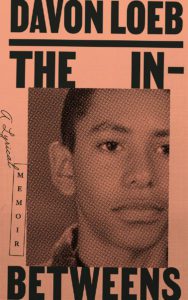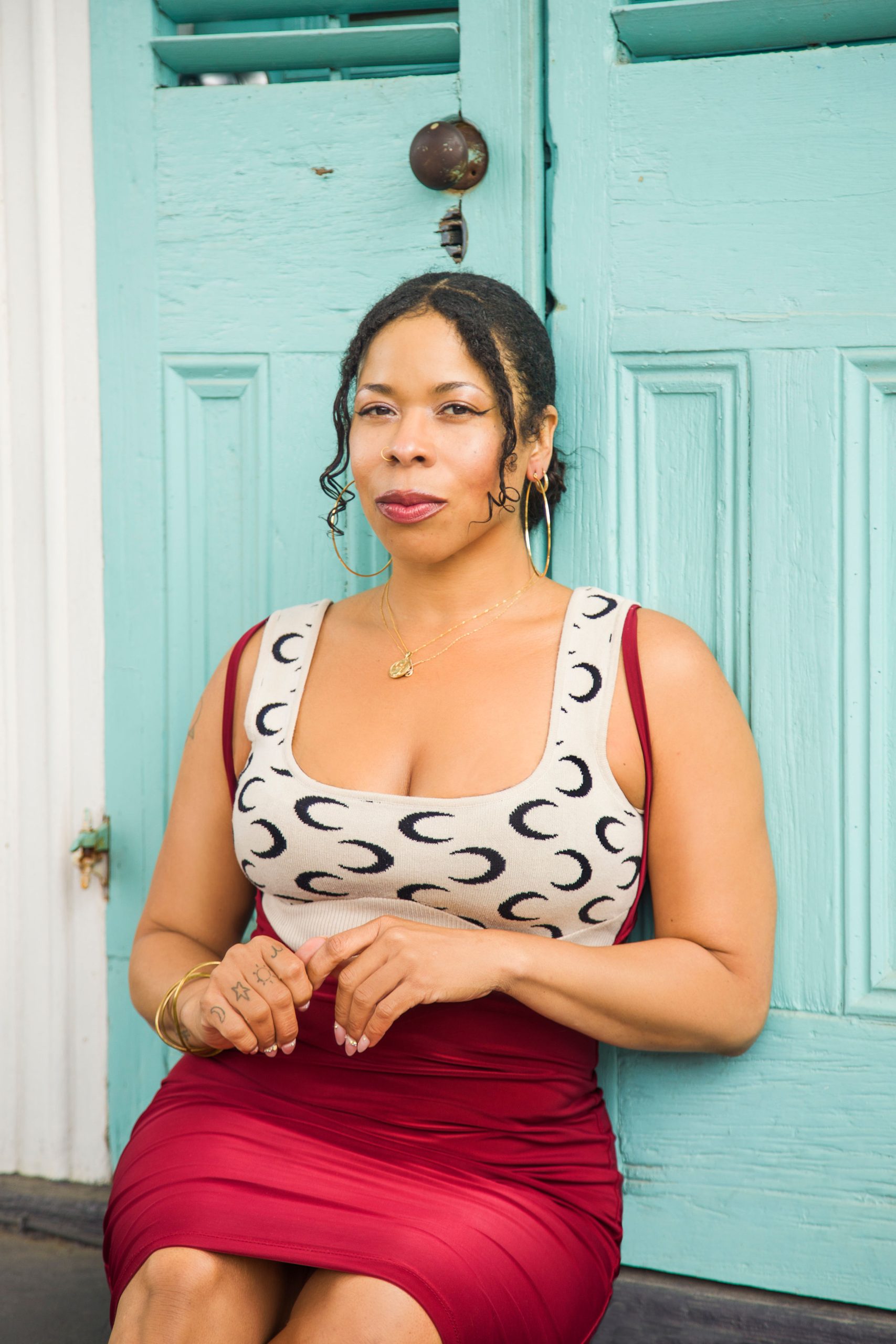My introduction to Davon Loeb was his essay, “Breakdancing Shaped Who I Am as a Black Man and Father,” a Notable Essay in The Best American Essays 2022. I was captivated by the vulnerability and relatability of Loeb’s writing, and quickly pre-ordered his debut lyrical memoir, The In-Betweens (West Virginia University Press, 2023). The book explores his growing up in the Pine Barrens of New Jersey as the son of a Black mother and white Jewish father. Loeb’s experiences growing up Black in a predominantly white-suburban neighborhood are often painful, yet not without joy. While the memoir is masterfully told—Loeb employs a variety of craft techniques that have a powerful effect—what makes The In-Betweens so special is the thoughtfulness Loeb brings to his work. Grappling with accountability and authority, Loeb leaves the reader wrestling with an important question we should all be asking: What is our culpability in systems of oppression?
I spoke with Loeb via Google Docs to discuss the transformation of the lyrical voice in The In-Betweens, developing trust with the reader, and the stickiness of relatability.
***
The Rumpus: I noticed in the acknowledgements how many of the essays have been previously published. It made me wonder about the genesis of the book. At what point did you know these essays were part of a larger work?
Davon Loeb: When completing my MFA at Rutgers-University Camden, I submitted many of the essays I workshopped to literary journals, partly because of literary affirmation. I wanted to get published so badly, which at times, trumped why I wrote. I think there’s real danger in that, submitting work just to get published versus writing good work to better your craft. However, the chapter, “Alabama Fire Ants” was first published in Portland Review, and when this happened, I felt like my writing succeeded, as if I reached a new level. “Alabama Fire Ants” was the chapter that inspired the entire collection, and that chapter can stand alone. Because of that, I wanted the rest of the book to mostly feature standalone pieces. I wanted to build context on a micro and macro level—that you could read The In-Betweens in medias res or from start to finish.
Rumpus: These read as individual essays, and there’s a strong narrative arc, but the book is described as a ‘lyrical memoir’ rather than an essay collection. Is that how you see it? As a memoir?
Loeb: I do see The In-Betweens as a memoir. I think the ultimate goal of writing this book was to explore the story of a boy trying to find himself throughout specific time periods. The lyrical voice is stretched, as if a muscle, in each chapter, and each chapter challenges the length of storytelling—challenges the notion that storytelling can be only a five-hundred-word paragraph or a two-thousand-word essay. This book is as much of a memoir of arrival as it is an exercise on craft, on how a book’s structure can be narratively and, concurrently, lyrically driven.

Rumpus: You use the first-person plural in many of the essays that explore childhood. Can you share what was behind that stylistic choice?
Loeb: Using the first-person plural was my very intentional attempt to tell an individual story universally. While my experiences as a person of color, as a person of color who is half white, as a heterosexual, cisgender, able-bodied man, as a college-educated teacher, as a middle class American, as someone with privilege but also without privilege, I wanted readers, regardless of their subjectivities, to see themselves in my book—that my story was their story. And so much of this is done with place, with summers in Alabama, with riding bikes in the Pine Barrens, with tropes of trying to fit in in middle and high school—all of which is purposeful, stylistically. The “we” is a syntactical choice to bind your story to mine.
Rumpus: Another compelling craft decision is the use of direct address, and the person being addressed varies. Two in particular have a chilling effect: “For My Brother,” in which the narrator addresses your brother who struggles with mental illness, and “On the Confederate Flag,” in which the narrator addresses a former friend who comes to school wearing a shirt that alludes to lynching. Why was it important to use direct address?
Loeb: The narrative voice evolves throughout the book. When we’re reading, “For My Brother” and “On the Confederate Flag,” there is a change in the narrator, a maturation. I wanted this redirection to reflect the narrator’s growth, to reflect his coming of age, and what better way to do that than to redirect how I told the story? That being said, these chapters use a direct address because I am more sure of myself, of how I tell the story and who I am talking to. Will my brother read this book? Will that friend feel racist guilt? There is no ambiguity here because I want you, whoever you are, to feel something, to feel an intimacy.
Rumpus: The growth of the narrator, including their growing confidence, is part of the narrative arc that creates intimacy, and brings us to a vulnerable space. Was this your intention?
Loeb: Writing a memoir is writing with authenticity rather than just the authority of the narrator. Because of this, I have a responsibility to write people accurately. These characters, often my family and friends, are as vulnerable as I am, and to be authentic is to write them fully—that they are never just one thing, and that was really important for me to prove. This book is not a collection of pointed fingers. This book is not to blame wrongdoers. This book never takes me off the hook. This book is about the hurt I have done and the hurt that has been done to me. I am accountable and should be—and that is the intimacy I am after.
Rumpus: How do you manage to center love in your work? Even when you’re writing about difficult topics or hurtful things?
Loeb: The In-Betweens is very much about love, and love is where the book starts, at the chapter, “A Love Story,” which is a retelling of my parents’ relationship. It seemed pivotal to begin my story here, before I’m born. My mother and father’s love story is an in-between—an in-between of age, race, culture—that “…he was white, and she Black, and this was America.” Love marries all the chapters, even if love is a criticism, even if love is a celebration. We can love our family but still be in conflict. We can love where we grew up but still criticize it. In “Something About Love,” my mother tells me that love instinctual, is an undeniable trust, is a comfort in knowing undoubtedly that you are safe and wanted and accepted, an irrefutable thing, like the sun coming out tomorrow, and there’s nothing more or less you can do on any given day to be unconditionally loved. Love is this, something unconditional, but love is not this; love can be a father’s inability to love unconditionally—and yet, love is also a man who is a verb, is an action, is a doer, a giver. Experiencing the duality of love, on many levels, is imperative to understanding the driving force behind my work.
Rumpus: Our society often takes a binary approach—you’re either this or that—but your work resists that. Why is it important to explore liminal spaces, or make room for the in-between places?
Loeb: I was raised in a Black-Latino family, my mother is Black, my stepfather is Panamanian, but I was half white, half Jewish. I grew up in a white town but was half Black. My culture and my ethnicity have always been in juxtaposition. For my entire life, I have always been in the in-between—not Black enough, not white enough. Society demands categorizations—demands our blood to be defined, whether we like it or not. I want to challenge that, the rigid belief that we are defined by one thing, one identity—because we are so much more than just our race, though, for many people of color, we cannot simply shed race, for we will still be Black, still be whatever thing society tells us we are.
Rumpus: Let’s talk about the town where you grew up. There were some very disturbing abuses you and your family were subjected to. One example is your brother’s teacher asking him to be O.J. Simpson in a class project in 1995.
Loeb: The town I grew up in is often the setting of both my creative nonfiction and fiction. I absolutely loved my experiences as a kid growing up in the New Jersey Pine Barrens. I spent my days after school riding bikes on backyard trails, playing basketball on neighborhood courts, chasing ice cream trucks down quiet suburban streets, drinking beers at parties in the deep woods. Growing up here, I was seemingly safe and wanted for nothing. I had a freedom that felt absolute. My writing celebrates this place with consistent image-driven narratives that intend to draw the reader in, from chapters like “The Settlers Inn” to “A Backseat and a Fire Pit”, my intention is for you to be here with me, with all of your senses. When I write about place, it is very poetic; however, place serves a greater purpose, which is to juxtapose joy with trauma. In the chapter, “On the Confederate Flag,” I am especially troubled by this, by loving my hometown, even though my classmates sported Confederate flags on their trucks at our football games. It’s the same when writing about Alabama: As a person of color, I think, “How can you write about the South without including racism?” Those years as a boy coming of age were joyous, but I was still an outsider to that place, the New Jersey Pine Barrens, to that culture. So my family and I absolutely encountered racism, like my brother did in “O.J. and the Wax Museum,” and yet, we had a good life, and I am so grateful for that.
Rumpus:. How do you balance writing about hard things while allowing room for pride, joy, and love?
Loeb: My life is not just hardship. So the pacing of the book follows joy and trauma shared in the same space, within the same chapters. Good memoir can marry joy and trauma because that’s how life is, and my book wants you to believe this marriage can exist in a literary form. On a craft level, many of the chapters embrace fragmented storytelling, whereas, I structure the narrative in vignettes, challenging traditional storytelling. A paragraph will celebrate while the next paragraph will critique, and this back-and-forth structure is a consistent thread that weaves all the chapters. Joy, love, trauma, rage—it can all exist together, in the same breath. My readers need to trust me, even when I will not tell them the entire story, even when details will be excluded, even when time has elapsed, even when the endings are ambiguous simply because memoir is life-writing, and life is messy but still demands balance.
Rumpus: That brings up interesting questions about the relationship between the writer and the reader—how is trust inherent to our engagement with a person’s story? How do you build trust on the page? By making it an invitation rather than an imperative?
Loeb: I think the invitation is when the reader sees themself in my memoir. Relatability is a power force, and I hope, as that happens at whatever point, the engagement intensifies. Once they’re on my hook, the stories resonate more, and we can approach the uncomfortable, like when readers experience the N-word, which is an experience, and the response, for many readers, is visceral and should be. I think getting there, when the -isms accumulate, takes trust. Readers will learn something from me, if they are not of color or of whatever thing I am and they are not. I believe, undoubtedly, there is learning, there is nuance, and there is growth happening between my narrator and my readers.
Rumpus: Does good storytelling challenge the idea that “relatability” comes from experiencing similar circumstances and events?
Loeb: Relatability is clearly an important narrative tool in The In-Betweens. But good writing and good storytelling has to exceed the relatable. As much as I want my readers to connect to my work because they can relate to it, I also recognize the danger here. Relatability can devalue and diminish a writer’s work. Just because a reader cannot relate does not mean the work is not important. Publishing can absolutely operate like this, using relatability to solely dictate what is publishable and what is not, which marginalizes already marginalized writers. Having a book that is relatable is great but saying a book is not relatable padlocks it. Relatability, especially for marginalized writers, is an exclusionary term that further narrows an outsider’s viewpoint on a literary work. “I cannot relate,” is synonymous with “this story does not matter to me.” Therefore, I think relatability is necessary and is demanded for non-white writers.
Rumpus: That reminds me of recent debates about empathy in writing, specifically who carries the burden of relatability, when it comes to feeling others’ pain.
Loeb: I was really adamant about not writing trauma as guilt-reading, but writers of color, especially, cannot write our histories without including trauma. My mother is Black, and we are a people from slaves, and it is impossible to tell you my story without including the traumatic history of Blacks in America. I do not need or want readers’ guilt, however I do expect readers to understand that my history is indefinitely tied to Black trauma—that I cannot tell you this story of being in between apart from it—that guilt is not required but respect is. And that is honest writing—writing that cares about the readers’ but cares more about the story it is trying to tell.
Rumpus: You write that your mom said you should always take injustice personally. Did your mom’s words fuel the heartbeat of much of the book?
Loeb: In the acknowledgements, I refer to my mother as the orator of our family history. Her role in my memoir, as the narrator, is as significant as mine, but she has a greater purpose that exceeds our relationship. My mother represents the Black voice where there is none. I do not have the authority to tell all parts of my story because I am only half Black. So I relinquish storytelling control over to her, and in many of the chapters, she takes narrative ownership and teaches me about my Blackness, about where I fit in America as a boy and young man of color. This is my mother’s duty and how she tries to protect me, which is a universal quality of most mothers, one that is as much about race as it is about survival. My mother’s omnipresence is clear and constant, and as we transition towards the end of the book, my mother and my voice become one, and I take injustice personally, like she taught me. The In-Betweens wants you to take injustice personally, to take my story personally.
***
Author photo by Frank Apollonio





